Blight is not the name of a particular disease that affects plants; rather, it is a group term for many problems that prevent plants from flourishing. Many factors contribute to the decline in yield and quality of commercially significant fruits and vegetables. In this article, we’ll give you a birds-eye perspective of the many blights that can strike plants and explain how to deal with each. Below we learn how to identify and control blight on plants, their causes, how to prevent blight, how to treat blight on plants, and what plant blight effect.
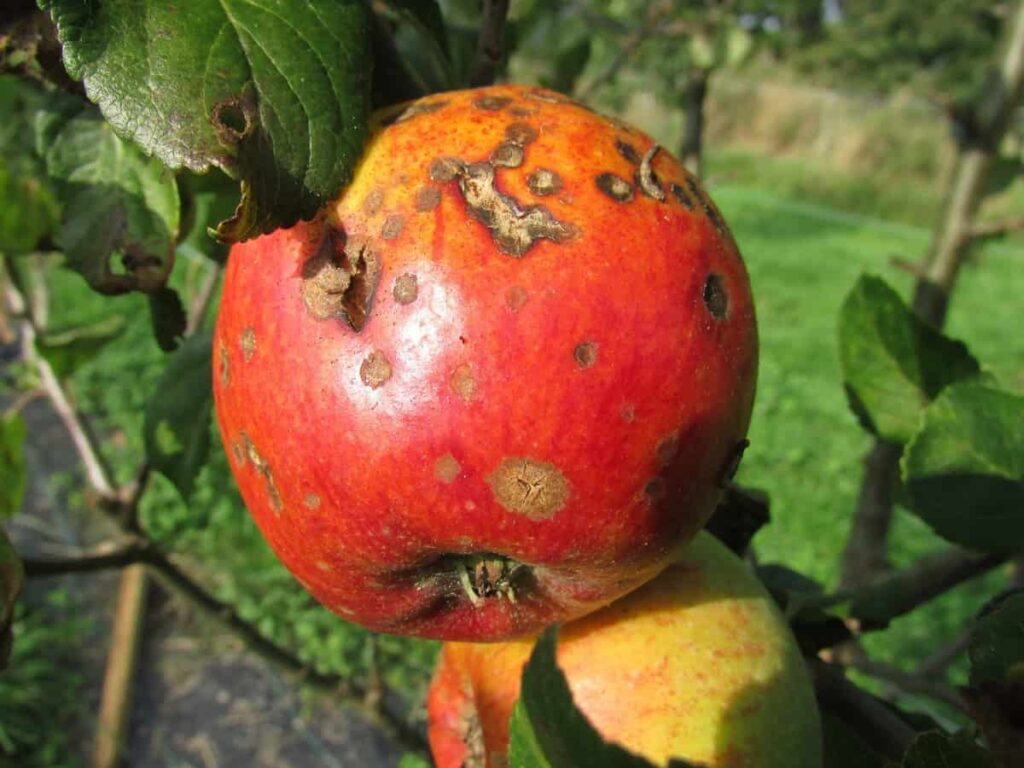
How to identify and control blight on plants
Types of blight
Common blight
Runner beans, french beans, mung beans, garden lupin, and peas are all vulnerable to common blight, a warm-weather disease. The pathogen can impact the plant’s leaves, stems, pods, and seeds, penetrating the plant via natural holes or wounds. Initial symptoms of this disease appear as water-soaked, angular leaf patches. As plant tissues die, the spots grow in size and eventually dry up.
Around the brown spots, a ring of yellow leaf tissue will form. The bacteria causes brown spots without a golden ring on the stems. Stem wilting is another symptom of infection. Pods and seeds may rot and become a muddy color, and bacterial slime can seep out of them when the humidity is high enough.
The use of disease-free seeds, crop rotation, the elimination of volunteer plants and weed hosts, and the restriction of overhead watering to keep leaves dry are all effective means of preventing the spread of common blight. The bacteria survive the winter on host waste and the soil surface. Therefore it’s necessary to take precautions to keep such places clean. Disease-resistant or tolerant varieties are also available.
Early blight
his disease, often known as tomato blight, is devastating to members of the Solanaceae family, which includes tomatoes, potatoes, and peppers. Brown lesions on leaves, encircled by a yellow halo, are the first sign of early blight. One of the hallmarks of this disease is the gradual appearance of concentric rings or a “bullseye” pattern among the lesions. Collar rot is caused by lesions that round the stem.
In case you missed it: How to Use Sticky Traps for Pest Control: Every Gardener and Farmer Must Know Before Starting Plants
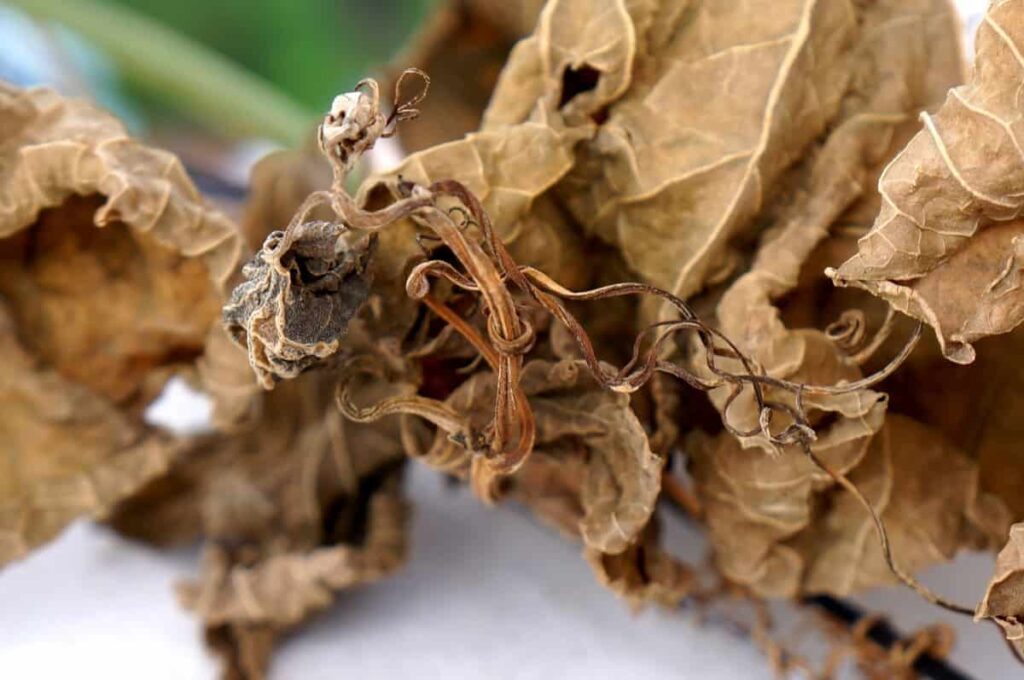
Brown spots, often with concentric rings, are a symptom of early blight, which can damage fruits and tubers. The premature dropping of tomato fruit is possible. Infected tubers often have leathery areas with a purple border that is slightly elevated. The early blight-causing fungus Alternaria solani requires high humidity and warm temperatures to thrive. Volunteer potato and tomato plants and nightshade weed hosts may serve as long-term reservoirs for this fungus.
Some critical cultural techniques include weed and volunteer control and eliminating diseased plant matter. Drip irrigation or limiting overhead watering throughout the growing season keeps leaf moisture low. Planting tomatoes in a location with plenty of air circulation can be protected them from harm. Soil nitrogen deficit has also been linked to this condition. Preventing blight can be aided by reducing plant stress and sticking to a regular fertilization schedule toward the end of the season.
Late blight
Potato plants with late blight first show water-soaked or chlorotic patches on leaves, quickly developing into black and brown lesions. Infastans, found in moist environments, produce white spores visible on plants. Even if you catch late blight in its early stages, the whole plant can be wiped out in only a few days. Secondary infections can also cause rot in potato tubers. The late blight can also destroy tomato plants.
Infections can spread from the plant’s leaves and stems to its fruits. Tomato plants are susceptible to wilt, and gardeners might lose their whole harvest if they plant them too early. Some potato varieties are more resistant to blight than others, but no variety is immune. The weather is the most critical factor in determining the spread of late blight.
This virus thrives in warm, wet environments with plenty of condensation. Some ways of management include spraying the foliage regularly, ensuring adequate drainage, and improving airflow. Dormant inoculants can also be stored in tubers. You should dig out the potato tubers and kill any volunteer plants that could grow in the soil.
In case you missed it: Okra Pests, Diseases, Symptoms, And Control Measures
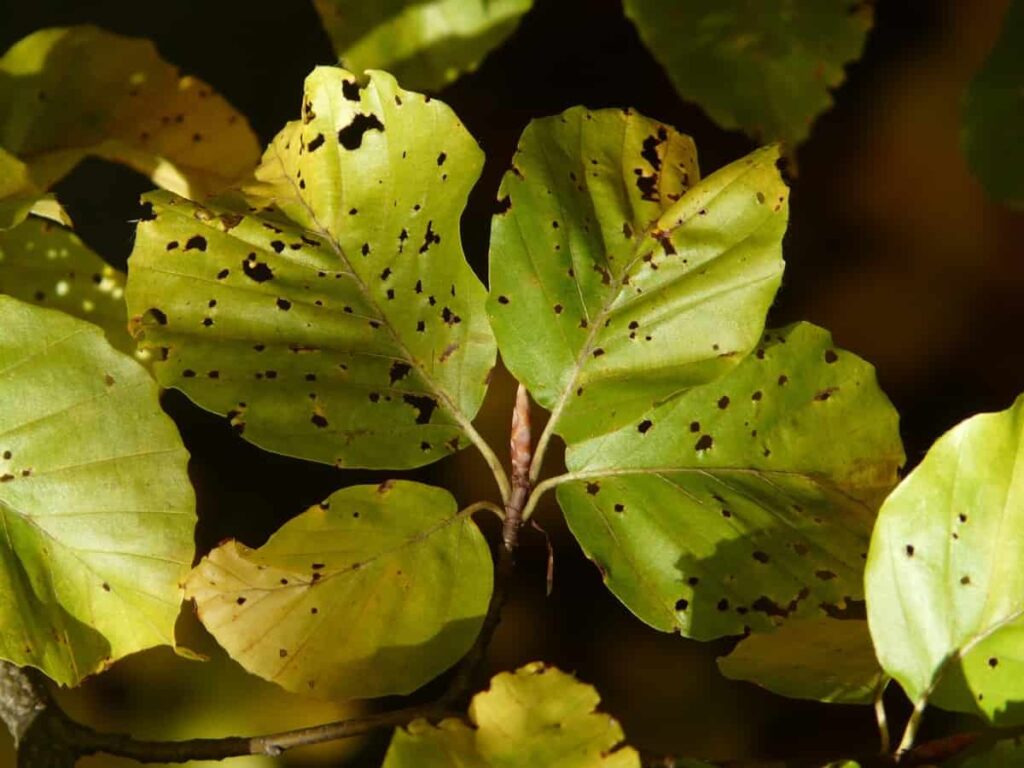
Fire blight
Pome trees and mountain ashes are particularly susceptible to fire blight, a bacterial disease caused by Erwinia amylovora. This fungus is also susceptible to raspberries, hawthorns, serviceberries, and cotoneasters. It thrives in hotter climates and increases when storms, high winds, or hails damage plants and leave them vulnerable to infection.
The bacteria that cause fire blight survive the winter in cankers and other tissue damage on afflicted plants. It can spread in various plant parts, including foliage, flowers, fruits, bark, branches, and young shoots. The black or brown discoloration of affected plant parts, giving them the impression of having been burnt, is the hallmark sign from which the disease derives its name.
As the shoots wither and die, they take on a distinctive “hook” form. Fruits that have been infected with the fungus will shrivel and become grey. All plants in the pome family are susceptible to fire blight, although some have a higher chance of surviving than others. Before the germs can spread and harm the whole plant, rapid action is necessary to clip affected branches using clean equipment.
Leaf blight
In the summer, tall fescue, Kentucky bluegrass, and perennial ryegrass fall victim to Ascochyta leaf blight, which is caused by the fungus Ascochyta spp. Although the disease is most common when temperatures are high and dry, researchers have learned little about the environmental conditions supporting this infection’s spread. Grass blades will soon turn a straw color and cluster together in extensive, erratic areas, much like during drought.
Nonetheless, this disease spreads rapidly, and some healthy leaves can be seen even among the patches. The tips of the leaves can become yellow and eventually perish. Wheat leaf blight begins as tiny lesions on the lower leaves and can eventually extend to the top leaves, sheaths, and seed heads. Fungus-secreted plant toxins are responsible for these wounds.
Additionally, sporulation and secondary windborne transmission are possible. A wheat field that has been heavily infested will seem bronzed and scorched. This disease can live for months in plant debris, so it’s best to eliminate it all. Seeds can be protected against mold by being presoaked in hot water (52-54°C for 10 minutes).
Septoria leaf spot
Similarly to early blight, septoria leaf spot often manifests itself initially on the lowest leaves of plants. Septoria leaf spot, on the other hand, manifests as a slew of small, brown dots on leaves rather than a few larger lesions per leaf. As the lesions expand, eventually, the leaves will fall off. Fruits are rarely affected by this disease.
In case you missed it: Ginger Diseases, Pests, Symptoms, And Control
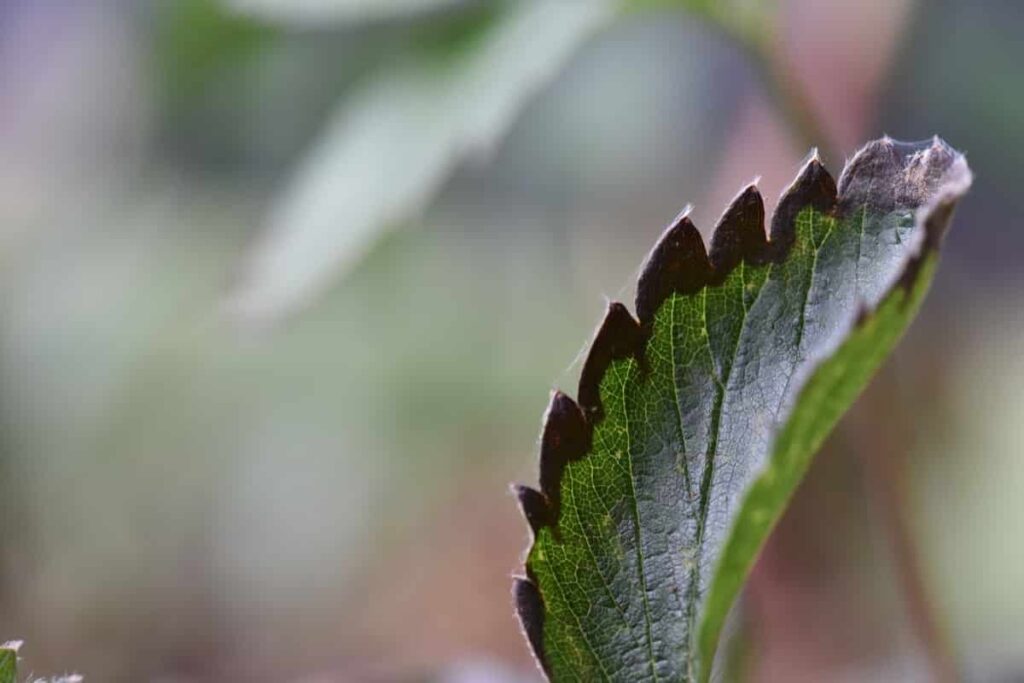
Septoria leaf spot and early blight spores may overwinter in the soil and reappear the next growing season. To thrive, late blight has to infect living tissue. Therefore it can’t overwinter in the soil. However, the spores that cause the disease can be carried by the wind up to 30 kilometers from afflicted plants.
Prevention and treatment for blight
If your tree contracts fire blight, there are several options for treatment. Pruning, a kind of mechanical disease management, is crucial. Pruning for disease control is crucial regardless of the other treatments or procedures used to combat fire blight. The summer and winter are ideal times to do disease control pruning since that is when the virus is not actively propagating through the tree. Get rid of infected branches out to a distance of 8 to 12 inches. Remove the diseased branch and its parent branch to the collar if possible.
During the dormant season, you can remove cankers from the trunk or scrape away the outer and inner bark on branches that are too big to trim. After you’ve scraped away all of the discolored tissue around the canker, cut away another 6-8 inches of bark in all directions. If this produces girdling (the removal of bark from more than half the diameter of a branch), the affected branch will need to be cut off altogether. In the event of girdling of the trunk, the tree must be cut down.
If a tree’s canopy is more than 50% unhealthy, it’s best to cut it down. Removing so much good tissue around the infected region can appear drastic, yet it is essential for effective disease control. Removing fire blight necessitates cutting away at healthy tissue around the afflicted region. Sealants applied to the trimmed or scraped area will only serve to keep in any lingering germs. Never prune till there have been 48 hours without any rain.
Between cuts, soak or spritz pruning tools with rubbing alcohol or 10% bleach. To prevent the bacteria from returning to your trees through birds, bugs, wind, or other vectors, do not compost any cut branches or bark; instead, remove the sick yard waste from your property. For best results, use copper during bloom every 4 to 5 days until the flowering period ends. Fruits can get scarred or rusted, although the disease is likely to be contained during its most contagious time of year.
But copper won’t help with pre-existing diseases in the wood. Its main function is to create a bacteriological barrier on the tree’s surface, stopping the transmission of infection to new places. If you’re a certified grower, check with your certifier before using copper or another insecticide. When pests like septoria leaf spots and early blight invade your garden, you must act swiftly to eradicate the problem by destroying or discarding infected foliage and branches.
If you haven’t done so before, mulch the area surrounding the plant’s base to stop water from splashing up and feeding the fungus. Next, try using a homemade or organic fungicidal spray to stop the spread. With late blight, it’s game over for the plant. To make the solution, gather one gallon of water, three teaspoons of baking soda, one tablespoon of vegetable oil, one teaspoon of dish soap, and a measuring spoon.
Put everything into a spray bottle after mixing. Be careful to apply the spray to the afflicted plants and their surroundings before the sun rises or after it sets. Each time it rains, you’ll need to reapply the repellent. Believe in no miracles. Probably, a huge epidemic can’t be stopped entirely, but the preceding method should assist in restricting its progress enough that you can still gather some fruit.
How do you control blight in plants?
Once blight has been definitively discovered, fast action is required to stop its spread. Pick up any infected leaves and dispose of them properly (by burning or trashing). Straw, wood chips, or another organic mulch spread around the plant’s base can stop soil-borne fungus spores from splashing up and infecting the plant. A fungicide should be used to prevent additional damage from blight if the disease has spread to more than a few leaves.
Plan for blight protection while growing tomatoes. Take these easy measures to maintain the health of your plants. Planting tomatoes in a plot that has previously housed other members of the Solanaceae family (eggplant, potatoes, and peppers) is an example of crop rotation. To ensure you choose a blight-resistant tomato, read the labels on the seed packets or plant containers thoroughly.
In case you missed it: Mango Pests, Diseases, and Control Methods – a Full Guide
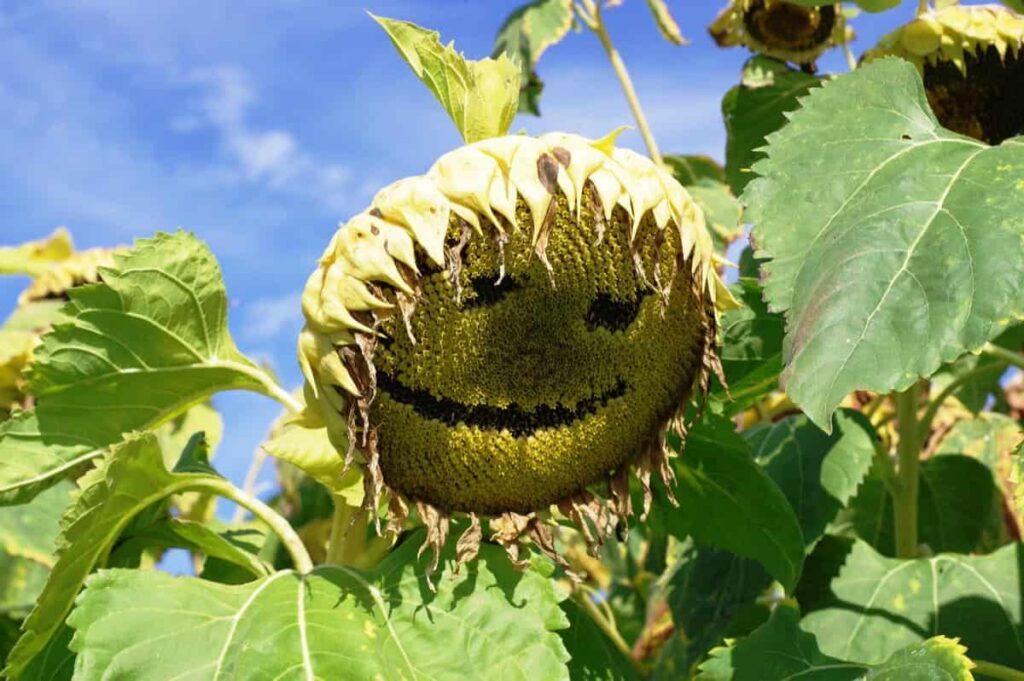
Cage or stake your tomato plants, so their leaves grow upward, away from the ground. Make sure you use much mulch around your plants. Instead of using a sprinkler to water your plants, try a soaker hose. This will prevent soil spores from splashing up onto plant leaves and minimize the quantity of water on the leaves. Maintain a routine of checking on your plants for symptoms of harm once every few days. A fast diagnosis and immediate treatment are the keys to a healthy, delicious crop.
How do you know if a plant has blight? / What is blight?
Blight refers to a group of diseases that can affect plants. The signs of blight include abrupt and severe yellowing, browning, spotting, withering, or death of leaves, flowers, fruit, stems, or the whole plant. Several different diseases can cause blight. Infestations of bacteria or fungi, the most common causes of blights, often target a plant’s shoots and other young, fast-developing tissues to spread their disease.
The circumstances that are most conducive to the development of bacterial and fungal blights are those that are chilly and damp. Most commercially significant plants, such as tomatoes, potatoes, and apples, as well as many decorative species, are vulnerable to at least one blight.
How do you get rid of blight organically?
When there isn’t adequate air circulation, moisture-loving pathogens like tomato blight and downy mildew flourish. Keeping your tomato plants at a healthy distance from one another can benefit both of them. Having enough space between plants also helps prevent the spread of fungal diseases. Mildew and blight can only thrive on damp plant parts. The likelihood of fungal infection can be reduced by eliminating any standing water around your plants.
Only moisten the soil surrounding the plant’s base while watering it. It’s easy for the spores of diseases like blight, mildew, and others to hang around in the soil surrounding your plants. Do everything you can to prevent soil contact with tomatoes and plant leaves. Switching where you keep your plants around can reduce fungal diseases.
Any soil-dwelling fungus spores will reinfect tomatoes planted in the same spot for two years. If possible, wait three years before growing tomatoes there again. It’s best to detect a fungal infection early on before it spreads. Recognizing sick plants is crucial for protecting the remainder of your crop from the quick spread of blight and mildew.
Does baking soda work for blight? / What can I spray for blight?
Due to the alkaline conditions created by the baking soda, fungi (powdery mildew and blight are fungi) cannot colonize the leaf surface. Fungi need a neutral pH (about 7.0) to grow and flourish. The pH of the leaf will increase from around 7.0 to about 8.0 after being sprayed with water and baking soda, which is adequate to kill or prevent all blight spores. To one gallon of water, add three teaspoons of baking soda. Add 1 tbsp of oil, preferably vegetable, but you can use whatever you choose.
This ensures that the spray remains on the leaves after the application. Throw in two drops of dishwashing liquid to help emulsify the mixture. Spray the upper and lower surfaces of the leaves until they drip. To start, use three teaspoons once weekly for three weeks. If the fungal growth or spread persists, increase the dosage to 3 1/2 Tablespoons. Spraying in the middle of the day can damage your leaves, so start early in the morning or late in the evening.
Which chemical can treat early blight in tomatoes?
Early blight in tomatoes calls for quick action to prevent the spread of the disease. Spray the plant down with a solution of Liquid Copper Fungicide concentrate, ensuring cover all surfaces (even the undersides of the leaves). These are both natural remedies. Schedule applications for 12 hours after dry weather. Remove the bottom branches with a razor knife the day following treatment.
Avoid spreading disease by wiping your knife clean with rubbing alcohol between plants. Apply fungicide again after 7 to 14 days. Pay close attention to the label’s use directions. When the temperature is in the high 80s or low 90s, spraying insecticides, fungicides, fertilizers, or herbicides can harm your plants. Make sure your plants are well-hydrated the day before you spray them.
What is the best spray for tomato blight?
It’s crucial to remember that certain fungicides, when used as directed, can be very effective. Fungicides not made for vegetables won’t help and can even harm the plants they’re applied to. Compost extracts and teas can be used as a remedy in organic gardening.
In case you missed it: Top 24 Steps to Boost Tomato Yield: How to Increase Production, Quality, and Size
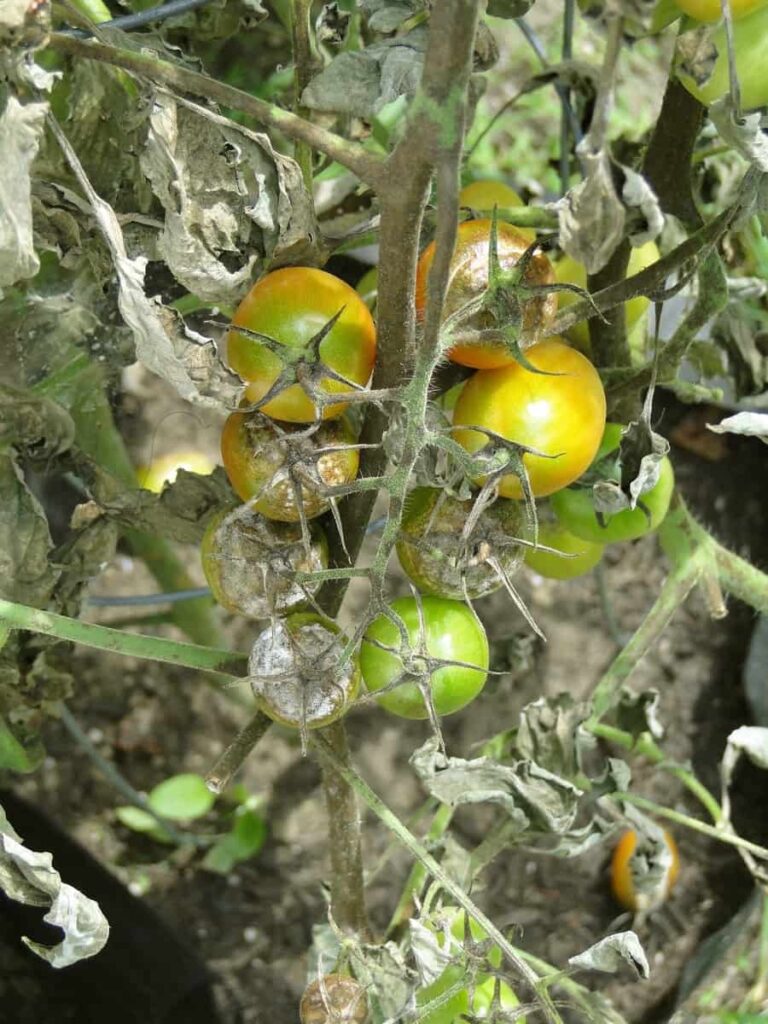
Spray the tomato plants with one gallon of water, one heaping of baking soda, one teaspoon of vegetable oil, and a few drops of mild soap. For continued effectiveness, this should be reapplied often. Disease spores can survive the winter on plants left in the yard from the previous year; therefore, cleaning up the garden is an essential preventive measure.
Conclusion
Some plant diseases are treatable. However, this varies greatly between pathogen and host species. You can control the blight disease if you follow the above procedures strictly. Also, don’t forget to maintain your garden clean.
- How to Make Houseplants Bushy: Effective Tips and Ideas
- Innovative Strategies for Boosting Coconut Pollination and Yield
- Pollination Strategies for Maximum Pumpkin Yield
- The Complete Guide to Chicken Fattening: Strategies for Maximum Growth
- Natural Solutions for Tulip Problems: 100% Effective Remedies for Leaf and Bulb-Related Issues
- Revolutionizing Citrus Preservation: Towards a Healthier, Greener Future
- Natural Solutions for Peony Leaf and Flower Problems: 100% Effective Remedies
- Maximizing Profits with Avocado Contract Farming in India: A Comprehensive Guide
- Natural Solutions for Hydrangea Problems: 100% Effective Remedies for Leaf and Flowers
- The Ultimate Guide to Choosing the Perfect Foliage Friend: Bringing Life Indoors
- From Sunlight to Sustainability: 15 Ways to Use Solar Technology in Agriculture
- The Ultimate Guide to Dong Tao Chicken: Exploring from History to Raising
- The Eco-Friendly Makeover: How to Convert Your Unused Swimming Pool into a Fish Pond
- Mastering the Art of Delaware Chicken Farming: Essentials for Healthy Backyard Flocks
- 20 Best Homemade Fertilizers for Money Plant: DIY Recipes and Application Methods
- How to Craft a Comprehensive Free-Range Chicken Farming Business Plan
- Brighten Your Flock: Raising Easter Egger Chickens for Beauty and Bounty
- How to Optimize Your Poultry Egg Farm Business Plan with These Strategies
- Subsidy for Spirulina Cultivation: How Indian Government Schemes Encouraging Spirulina Farmers
- Ultimate Guide to Raising Dominique Chickens: Breeding, Feeding, Egg-Production, and Care
- Mastering the Art of Raising Jersey Giant Chickens: Care, Feeding, and More
- Ultimate Guide to Raising Legbar Chickens: Breeding, Farming Practices, Diet, Egg-Production
- How to Raise Welsummer Chickens: A Comprehensive Guide for Beginners
- How to Protect Indoor Plants in Winter: A Comprehensive Guide
- Ultimate Guide to Grow Bag Gardening: Tips, Tricks, and Planting Ideas for Urban Gardeners
- Guide to Lotus Cultivation: How to Propagate, Plant, Grow, Care, Cost, and Profit
- Agriculture Drone Subsidy Scheme: Government Kisan Subsidy, License, and How to Apply Online
- Ultimate Guide to Raising Araucana Chickens: Breed Profile, Farming Economics, Diet, and Care
- Bringing Hydroponics to Classroom: Importance, Benefits of Learning for School Students
- Ultimate Guide to Raising Polish Chickens: Breed Profile, Farming Economics, Diet, and Care
- Ultimate Guide to Raising Australorp Chickens: Profile, Farming Economics, Egg Production, Diet, and Care
- Silkie Chicken Farming: Raising Practices, Varieties, Egg Production, Diet, and Care
- Sussex Chicken Farming: Raising Practices, Varieties, Egg Production, Diet and Care
- Homemade Feed Formulations for Livestock: Discover Cost-effective Starter to Finisher Feed Recipes
- 20 Best Pig Weight Gain Supplements: Top Swine Weight Gain Formulas
- Ultimate Guide to Elderberry Farming: Propagation, Planting, Yield, Cost, and Profit